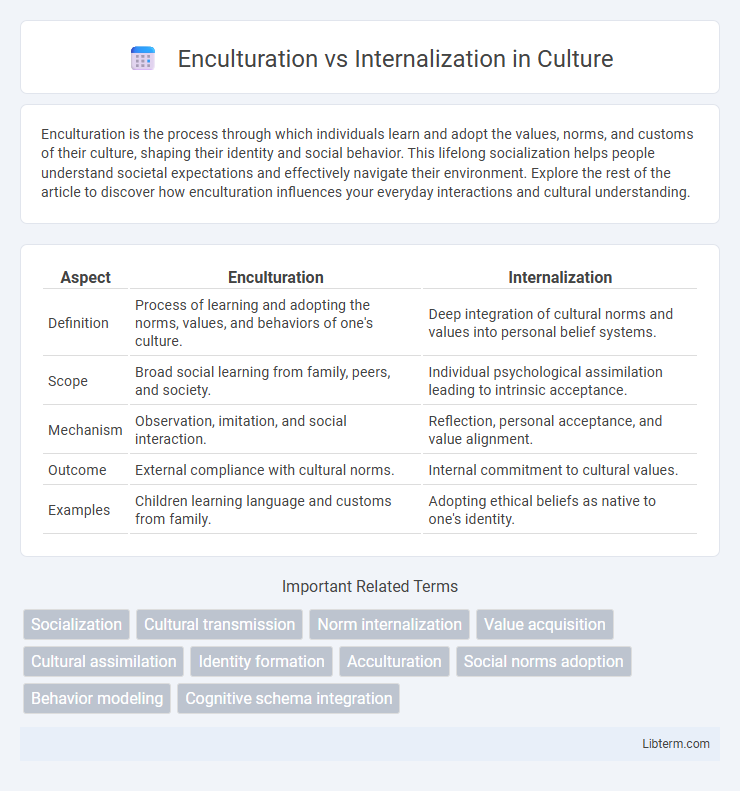Enculturation is the process through which individuals learn and adopt the values, norms, and customs of their culture, shaping their identity and social behavior. This lifelong socialization helps people understand societal expectations and effectively navigate their environment. Explore the rest of the article to discover how enculturation influences your everyday interactions and cultural understanding.
Table of Comparison
| Aspect | Enculturation | Internalization |
|---|---|---|
| Definition | Process of learning and adopting the norms, values, and behaviors of one's culture. | Deep integration of cultural norms and values into personal belief systems. |
| Scope | Broad social learning from family, peers, and society. | Individual psychological assimilation leading to intrinsic acceptance. |
| Mechanism | Observation, imitation, and social interaction. | Reflection, personal acceptance, and value alignment. |
| Outcome | External compliance with cultural norms. | Internal commitment to cultural values. |
| Examples | Children learning language and customs from family. | Adopting ethical beliefs as native to one's identity. |
Understanding Enculturation: A Cultural Foundations Overview
Enculturation is the process by which individuals learn and adopt the values, customs, and behaviors of their surrounding culture through direct interaction and socialization within their community. It involves the transmission of cultural knowledge from one generation to the next, shaping an individual's identity and worldview. Understanding enculturation reveals how cultural norms become deeply ingrained, influencing social practices and communication patterns across diverse societies.
Internalization: The Psychological Adoption of Values
Internalization involves the deep psychological adoption of values, where external norms become an integral part of an individual's belief system, guiding behavior intrinsically. This process enables values to be upheld even without external enforcement, reflecting genuine personal commitment. Unlike enculturation, which emphasizes cultural transmission through social exposure, internalization signifies a more profound, internal acceptance and integration of cultural values.
Key Differences Between Enculturation and Internalization
Enculturation refers to the process by which individuals learn and adopt the cultural norms, values, and behaviors of their society through observation and interaction, while internalization involves the deep acceptance and integration of these cultural elements into an individual's belief system and identity. Key differences include that enculturation is primarily external and social, emphasizing learning from the environment, whereas internalization is internal and psychological, emphasizing personal acceptance and consciousness. Enculturation shapes surface behaviors and social conformity, whereas internalization governs intrinsic motivation and moral reasoning.
How Enculturation Shapes Individual Identity
Enculturation shapes individual identity by immersing a person in the customs, language, and values of their native culture from early childhood, which deeply influences their worldview, behavior, and social roles. This process operates through family traditions, educational systems, and peer interactions, embedding cultural norms that guide daily decision-making and personal beliefs. Through enculturation, individuals develop a sense of belonging and self-concept tied directly to their cultural heritage, distinguishing it from internalization where values become personally integrated beyond cultural conformity.
The Process of Internalization in Personal Development
The process of internalization in personal development involves absorbing societal norms, values, and beliefs until they become integral to an individual's identity and decision-making framework. Unlike enculturation, which is the broader cultural learning process, internalization specifically transforms external principles into intrinsic motivations guiding behavior unconsciously. This process shapes character, influences emotional responses, and fosters consistent behavioral patterns essential for personal growth and social adaptation.
Cultural Transmission: Mechanisms of Enculturation
Enculturation involves the process by which individuals learn and adopt the norms, values, and behaviors of their culture through observation, imitation, and direct instruction from social environments such as family, peers, and media. Internalization refers to the deep integration of cultural norms into one's belief system, making them automatic guides for behavior without conscious awareness. Mechanisms of enculturation include language acquisition, ritual participation, and social reinforcement, which facilitate cultural transmission by embedding cultural knowledge across generations.
Psychological Factors Influencing Internalization
Psychological factors influencing internalization include cognitive development, emotional attachment, and motivation, which shape how individuals absorb and integrate cultural norms into their self-concept. Internalization involves the transformation of external values into personal beliefs, driven by internal psychological processes such as identity formation and moral reasoning. Enculturation differs as a broader social process, but internalization emphasizes the individual's internal psychological engagement in adopting cultural standards.
Enculturation and Internalization in Childhood Development
Enculturation in childhood development refers to the process by which children absorb their culture's values, norms, and behaviors through observation, imitation, and social interaction within family and community settings. Internalization occurs when these cultural norms and values become deeply integrated into a child's belief system, guiding behavior even in the absence of external enforcement. Understanding the distinction between enculturation as initial cultural learning and internalization as the embedding of these learned values is crucial for analyzing socialization patterns in childhood.
Social Institutions: Drivers of Enculturation and Internalization
Social institutions such as family, education systems, and religious organizations serve as primary drivers of enculturation by transmitting cultural norms, values, and behaviors to individuals. Internalization occurs as individuals absorb these cultural elements deeply, shaping their identity and guiding their social actions unconsciously. The structured interactions and rituals within social institutions reinforce both enculturation and internalization processes, ensuring cultural continuity and social cohesion.
Impacts on Behavior: Comparing Outcomes of Enculturation vs Internalization
Enculturation shapes behavior by embedding cultural norms and practices through social interaction, leading to behaviors aligned with group expectations. Internalization results in deeper acceptance of values, causing individuals to act consistently with internal beliefs even when external pressures are absent. The primary difference is that enculturation influences behavior via external reinforcement, while internalization drives intrinsic motivation and personal commitment.
Enculturation Infographic

 libterm.com
libterm.com